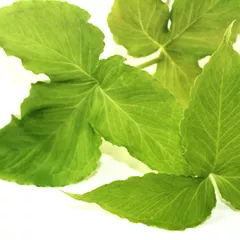Damp-Phlegm in the Lungs
The information provided here is not a replacement for a doctor. You shouldn't use it for the purpose of self-diagnosing or self-medicating but rather so you can have a more informed discussion with a professional TCM practitioner.
At a glance
Preliminary reading: What is a pattern? The concept of Phlegm The Lungs in Chinese Medicine The concept of Dampness
Key attributes
Chinese name: 湿痰阻肺 Pinyin name: Shī Tán Zǔ Fèi
Pattern nature: Full
Causes
Precursor patterns: Kidney Yang Deficiency Spleen Qi Deficiency Wind-Heat invading the Lungs
Common causes: 1. Exterior Wind and Cold Evils, 2. Diet
Diagnosis
Common symptoms: Nausea Asthma Coughing Wheezing Pale face and eight other symptoms
Pulse type(s): Slippery (Hua), Soggy (Ru)
Tongue description: Swollen tongue with sticky white coating
Treatment
Treatment principle: Remove Dampness and Phlegm, restore the descending of Lung Qi.
Common formulas: Er Chen Tang
Pathology
Phlegm in the Lungs is synonymous with Substantial Phlegm. It is Phlegm that is located in the Lungs and that can be seen. It is manifested by the swollen tongue. The main symptoms, on top of general Phlegm symptoms, are the heavy sputum that develops in the Lungs and throat as well as, in some cases, asthma or difficulty to breath.
This Phlegm is associated with or deriving from Dampness. This type of Damp-Phlegm can be reflected by the sticky white tongue coating and profuse white sputum.
The pattern can be acute or chronic. In acute cases, it is normally caused by Wind invasion of the Lungs. If the patient's immune system is not strong enough to defense this Pernicious Evil, the patient then develops acute cough with profuse sputum.
In chronic cases, it is often the result of Spleen Deficiency. It is because the Spleen is responsible for Body Fluids transformation and transportation and its dysfunction leads to Phlegm formation, which then get stored in the Lungs.
As a result, the descending of Lung Qi is greatly disturbed, thus the symptoms of coughing and short of breath. The Pale complexion shows the Spleen and Lung Yang Deficiency.
The patients usually dislike lying down, because the horizontal position make the chest pain, stifling and distention condition even worse due to the obstructed chest and Lungs by Phlegm. This Phlegm also obstructed the head's orifices which then cause the feeling of muzziness, dizziness and head heaviness.
In acute cases, the patient's Qi is usually not weakened which indicates a purely Full pattern, then the pulse is Slippery. However, the pulse is Soggy in chronic cases, which means the Qi is harmed to certain degree.
Causes
Precursor patterns: Damp-Phlegm in the Lungs can derive from Kidney Yang Deficiency Spleen Qi Deficiency Wind-Heat invading the Lungs
Exterior Wind and Cold Evils: Recurrent exterior Wind and Cold Evil attacks can harm the Lungs and the Spleen function and give rise to Phlegm accumulating in the Lungs.
Diet: Over consumption of greasy foods, cold or raw foods or dairy foods can cause the accumulation of Phlegm, which settles in the Lungs.
Diagnosing Damp-Phlegm in the Lungs
Diagnosing a pattern in Chinese Medicine is no easy feat and should be left to professional practitioners. In particular one has to know how to differentiate between different types of pulses and tongue coatings, shapes and colors as well as learn to read from a long list of seemingly unrelated symptoms.
Pulse type(s): Slippery (Hua) or soggy (Ru)
Tongue description: Swollen tongue with sticky white coating
Main symptoms: Nausea Asthma Coughing Wheezing Pale face Dizziness Chest fullness Phlegm in throat Shortness of breath Feeling of heaviness Profuse white sputum Dislike of lying down Stifling sensation in the chest
Diagnosis commentary: Key characteristic symptoms of this pattern are the sticky white tongue coating and chronic cough with large amount of white sputum.
Treating Damp-Phlegm in the Lungs
Treatment principle
Remove Dampness and Phlegm, restore the descending of Lung Qi.
Herbal formulas used to treat Damp-Phlegm in the Lungs



The top herbs in Er Chen Tang are Crow-Dipper Rhizomes (Ban Xia), Tangerine Peel (Chen Pi) and Poria-Cocos Mushrooms (Fu Ling)
Er Chen Tang
Source date: 1148 AD
Number of ingredients: 5 herbs
Key actions: Dries Damp and dispels Phlegm. Regulates Qi and harmonizes the Middle Burner (Stomach and Spleen).
Formula summary
Er Chen Tang is a 5-ingredient Chinese Medicine formula. Invented in 1148 AD, it belongs to the category of formulas that dry Dampness and transform Phlegm.
Besides Damp-Phlegm in the Lungs, Er Chen Tang is also used to treat Damp-Phlegm or Phlegm-Fluids.
Diet recommendations
As for food, avoid cold and raw foods, dairy, greasy, spicy, fried food. Also avoid alcohol or tobacco. Try simple warm soups or vegetable juice until the patients are recovered.
Cupping over the chest or upper back, nasal wash and breathing exercises can also help healing.
Finally, the patients should take as much as bed resting.
Consequence patterns
Dampness and Phlegm from the Lungs can obstructs the Spleen and cause Spleen Qi Deficiency. As vicious circle, it makes the original condition of Damp Phlegm in the Lungs worse.
Accumulation of Phlegm in the Lungs can cause Dryness in other parts of the body, especially for the elderly.
Phlegm in the Lungs can cause Dryness and Body Fluids Deficiency in other part of the body. Since Blood is one form of Body Fluids and it can become stagnated eventually, especially for the elderly.
